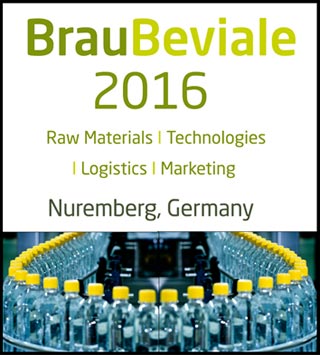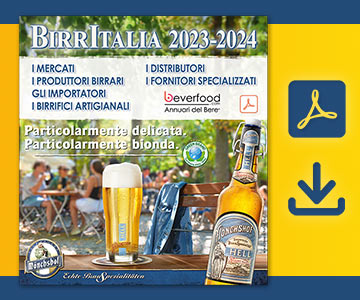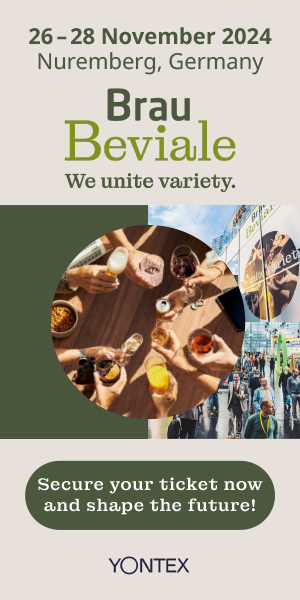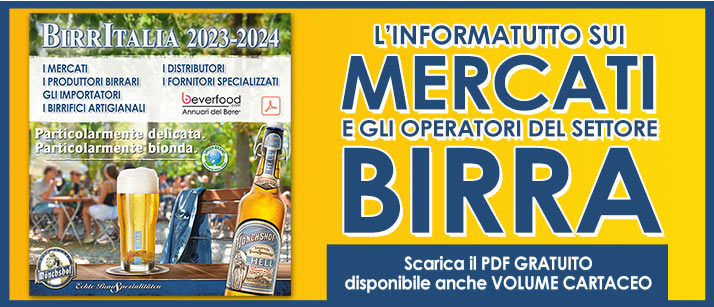Creatività, naturalezza e convenience al centro dell’attenzione. La birra è il cuore della BrauBeviale. L’imbarazzo della scelta di imballaggi per bevande. Il mercato delle bevande resta stimolante: evidentemente ormai le classiche varianti di bevande non bastano più al consumatore.
 In ogni segmento nascono ormai i cosiddetti craft drink. Ecco quindi che, accanto ai grandi gruppi, si vanno affermando sul mercato numerose aziende medie e piccole o piccolissime il cui obiettivo dichiarato è quello di offrire qualità invece che quantità: perché spesso produrre meno significa, infatti, aumentare la qualità. Manca ancora poco
In ogni segmento nascono ormai i cosiddetti craft drink. Ecco quindi che, accanto ai grandi gruppi, si vanno affermando sul mercato numerose aziende medie e piccole o piccolissime il cui obiettivo dichiarato è quello di offrire qualità invece che quantità: perché spesso produrre meno significa, infatti, aumentare la qualità. Manca ancora poco
all’appuntamento che vedrà il mondo delle bevande europeo riunito a Norimberga per dialogare su tendenze e novità. Dall’8 al 10 novembre gli esperti si incontrano a quello che quest’anno è il salone più importante dedicato ai beni d’investimento dell’industria delle
bevande.
Una cosa non cambia: a livello planetario si beve sempre di più. Secondo Canadean, nel 2015 il consumo di bevande globale è stato di circa 280 litri pro capite. Vale a dire di oltre 13 litri in più rispetto allo scorso anno. Per il 2016 l’istituto di ricerche di mercato prevede di nuovo un lieve aumento a 284 litri. Le regioni in cui si beve di più sono l’America Latina (587 litri pro capite) e il Nord America (579), seguiti dall’Europa occidentale (542).
Fanalino di coda nel confronto internazionale è l’Africa con circa 70 litri pro capite. Indipendentemente dalla bevanda, alla BrauBeviale i produttori, distributori, commercianti e ristoratori trovano tutto ciò che riguarda l’intera filiera: dalle materie prime giuste alle tecnologie efficienti, dalla logistica ideale alle idee di marketing che calzano a pennello, non mancano poi zone di degustazione neutrali.
Costante la vendita di birra in Germania
In testa alla classifica delle categorie di bevande nel 2015 ci sono stati i softdrinks con circa 97 litri a testa. Per quanto riguarda le bevande alcoliche il punteggio più alto l’hanno ottenuto la birra e il sidro. Ne sono stati bevuti circa 28 litri a testa (Canadean). Secondo il Deutscher Brauerbund (Federazione tedesca dei birrai) nel 2015 la vendita di birra in Germania è rimasta praticamente costante.
Complessivamente le vendite di birra si sono aggirate sui 96 milioni di ettolitri e il consumo pro capite è stato di 106 litri. Per quanto riguarda i beer mix la tendenza è rimasta regressiva. Con quattro milioni di ettolitri hanno fatto circa il quattro percento delle vendite di birra complessive. La Germania è la massima produttrice europea di birra davanti a Russia, Gran Bretagna, Polonia e Spagna (dati dell’Ufficio Federale di Statistica, Statistisches Bundesamt). A livello internazionale il primo posto è occupato dalla Cina, seguita da USA e Brasile. In generale, l’Asia rappresenta, accanto all’Africa, il mercato della birra più interessante del futuro almeno per quanto riguarda la crescita media annuale: entro il 2020 raggiungerà il tre per cento in Asia e persino il cinque percento in Africa. Per il Nord America e per l’Europa, sia orientale che occidentale, Canadean prevede invece una crescita dell’un percento al massimo.
Qualità e varietà sono imprescindibili
Negli anni passati la creatività è stata un imperativo generale per l’industria birraria, e questo praticamente in tutto il mondo. Infatti i consumatori non desiderano solamente che la birra sia fatta con ingredienti naturali ma vogliono al tempo stesso esperienze gustative sempre più varie e creazioni sempre nuove: possibilmente di produttori regionali. Da uno studio Alltec risulta che oggi esistono già più di 10.000 birrifici “craft”. L’86 percento di essi è distribuito in parti uguali fra Nord America ed Europa. I primi dieci stati nella classifica dei birrifici “craft” sono USA, Gran Bretagna, Francia, Italia, Russia, Canada, Svizzera, Germania, Brasile e Giappone.
Un sondaggio di Mintel rivela che ai tedeschi la birra craft piace sempre di più. Se nel 2012 proveniva dal segmento “craft” solo un percento delle nuove birre lanciate sul mercato, nel 2014 si raggiunse già il 12 percento e nel 2015 si era quasi al 20 percento. Nell’ottobre 2015 Mintel ha appurato inoltre che quasi un quarto dei tedeschi che bevono birra aveva acquistato una birra craft nei sei mesi precedenti per consumarla a domicilio mentre, e non è poco, il 16 percento ne aveva ordinata una in un locale. Regionalità e varietà di sapori sono gli aspetti dominanti, che sono stati citati in questo campo.
Tema d’attualità: la cultura creativa delle bevande
Ricchezza di idee e sapori fuori dal comune sono elementi centrali anche alla BrauBeviale, per esempio al Craft Beer Corner. Vi sono cinque banconi ai quali sommelier offrono degustazioni guidate su un tema specifico: luppolo, malto, lievito, specialità e varietà di bicchieri per differenziare l’esperienza gustativa. Proprio per i visitatori professionali della ristorazione e del commercio si presenta qui l’occasione di scoprire birre originali sotto la guida di professionisti e senza preconcetti. Un altro bancone di degustazione offre bevande spiritose premium. Vi è inoltre un appuntamento di spicco sul tema della varietà di birre internazionali: il conferimento e la presentazione delle European Beer Star da parte dell’ente promotore della manifestazione, le Private Brauereien Bayern.
Collaudatissima e amatissima è la degustazione dei Consumers‘ Favourites durante la prima giornata della fiera. E per chi tutto ciò non basta c’è il party dopo fiera di Schanzenbräu & Friends dove si possono gustare altre birre craft appena spillate in un’atmosfera effervescente. Il tutto è coronato da qualcosa di solido fornito dai food truck partecipanti per rendere perfetta la serata. I truck danno il via alla SFC, cioè la Street Food Convention che inizia l’ultima giornata della BrauBeviale. Allo European MicroBrew Symposium, organizzato insieme alla Versuchs- und Lehranstalt für Brauerei (Istituto sperimentale e di insegnamento per birrifici, VLB) i sostenitori della cultura creativa della birra possono dialogare già alla vigilia della fiera su questioni attuali riguardanti la realtà pratica: tendenze, mercati e tecnologie. Grazie al percorso contrassegnato sul tema della cultura creativa delle bevande, i visitatori della fiera potranno orientarsi facilmente negli otto padiglioni.
Imballaggi per bevande: il contenitore è fondamentale
Una questione da risolvere sempre e indipendentemente dal tipo di bevanda è quella del contenitore da utilizzare. In generale ci si chiede: lattina, vetro o PET? Ma ultimamente c’è una novità discussa sempre più spesso anche nel comparto delle bevande: si tratta della stand-up pouch, ovvero di sacchetti che stanno in piedi. Sono leggeri, facili da trasportare e lasciano gustare comodamente il loro contenuto. Per l’acqua il contenitore prediletto è tuttora la bottiglia, soprattutto di PET. Succhi e nettari di frutta sono venduti spesso in imballaggi di cartone, seguiti dalla bottiglia di PET. Proprio per i prodotti artigianali si assiste al ritorno di lattine e bottiglie di vetro.
Sul tema degli imballaggi per bevande la BrauBeviale presenta un’offerta alquanto vasta: dai materiali e dai mezzi per l’imballaggio, ai prodotti ausiliari per imballaggi e ai sistemi di chiusura. PET@BrauBeviale offre inoltre soluzioni interessanti sull’intera catena del valore del PET. Chi viene con il chiaro obiettivo di raggiungere determinati espositori e offerte sul tema PET deve semplicemente seguire il percorso contrassegnato. Competenza internazionale nel comparto delle bevande NürnbergMesse dimostra la sua competenza in fatto di industria delle bevande non solo con la BrauBeviale di Norimberga, ma anche nel mondo.
Dal 28 febbraio al 2 marzo 2017, dopo l’esordio di successo dello scorso anno, si svolgerà per la seconda volta la Beviale Moscow, salone dedicato ai beni d’investimento rivolto prevalentemente al mercato della Russia e dell’Europa orientale. Inoltre sarà tenuto a battesimo il progetto più recente del portafoglio: la China Craft Beer Conference & Exhibition (CBCE) che si terrà a Shanghai il 26 e il 27 maggio 2016. Sono in preparazione ulteriori progetti.
ALTRE NEWS BRAU BEVIALE
Referenti stampa e media
Sabine Ziener, Ruth Cuya
T +49 9 11. 86 06-83 29
F +49 9 11. 86 06-12 83 29
ruth.cuya@nuernbergmesse.de
BrauBeviale 2016: Developments and trends on the beverage market – Focal point: beer
Creativity, naturalness and convenience the focal point. Beer the heart of BrauBeviale. Spoilt for choice in beverage packaging.
The beverage market remains exciting, there are now clearly not enough classic beverage variations for the consumer. So-called craft drinks are now already part of every segment. As a result, in addition to major groups, numerous medium-sized, small and the smallest companies are establishing themselves on the market, their declared objective is to offer quality instead of quantity – less is simply often more. But not for long, because then the European beverage trade world will once again be the guest in Nuremberg and enter into an exchange on trends, new products and innovations. From 8 to 10 November, the experts will come together at this year’s most important equipment show for the beverage industry.
The following still applies: worldwide drinks consumption is continuing to rise. According to Canadean, in 2015 global beverage consumption reached approx. 280 litres per capita, that is around 13 litres more than the previous year. For 2016 the market research institute is predicting a further slight increase to 284 litres. The most drinks are consumed in Latin America (587 litres per capita) and North America (579), followed by Western Europe (542). Bottom of the international rankings is Africa with around 70 litres per capita. Regardless of which beverage we are dealing with – at BrauBeviale, producers, sales and marketing people, the retail and catering trade find everything connected with all aspects of the entire process chain: extending from the suitable raw materials through to efficient technologies and perfectly coordinated logistics right up to coherent marketing ideas and neutral tasting zones.
Beer sales in Germany constant
In 2015, soft drinks were the worldwide leaders in the beverage categories at around 97 litres per person. Among the alcoholic drinks the most successful were beer and cider. Around 28 litres per capita were drunk. (Canadean).
In Germany, according to the Deutscher Brauerbund (DBB, German Brewers Association), beer sales in 2015 were as good as constant. Total beer sales reached around 96 million hectolitres, almost 106 litres per capita were drunk. In the shandy drinks category the trend continues to be in decline. At four million hectolitres they accounted for about four percent of total beer sales. Germany is ahead of Russia, Great Britain, Poland and Spain as the largest European beer producer (Statistisches Bundesamt / Federal Statistical Office). Number one in the world is China ahead of the USA and Brazil. Generally, Asia alongside Africa represents the most interesting beer market for the future – at least as far as annual average growth is concerned: by 2020 this is set to reach three percent in the Asian region, in Africa even five percent. In North America, Eastern and Western Europe in contrast, Canadean assumes a maximum increase of one percent.
It must be high quality and diverse
In the past few years creativity has become a familiar expression for the brewing industry – this is practically the case worldwide. In this connection, the consumers are not only looking for beer, which is brewed using natural ingredients, but at the same time, increasingly diverse flavour experiences and new creations all the time – with a preference for regional producers. According to an Alltec study, there are today already more than 10,000 craft breweries worldwide. 86 percent of them are approximately equally divided between North America and Europe. The top ten nations for craft breweries are the USA, Great Britain, France, Italy, Russia, Canada, Switzerland, Germany, Brazil and Japan. A survey conducted by Mintel shows that the German population is increasingly embracing craft beer. Whereas in 2012 only one percent of beers newly introduced to the market came from the craft beer sector, in 2014 it was already 12 percent and in 2015 almost 20 percent. In addition, in October 2015, Mintel established: in the six months previously almost one quarter of German beer drinkers had bought a craft beer for private consumption and no less than 16 percent had ordered such a beer in pubs and restaurants. Regionality and flavour diversity are the key aspects appreciated here.
Creative Beverage Culture the trend theme
Inventiveness and exceptional flavour are also central elements at BrauBeviale, for example in the Craft Beer Corner. There, at five bars, each on a different theme, sommeliers are offering guided tasting sessions: hops, malt, yeast, specialties and different glass designs for different types of drinking enjoyment. Trade visitors from the catering sector and retail trade in particular will have the opportunity here to discover exceptional beers with professional guidance and assistance on an impartial basis. A further tasting bar is offering premium spirits. There is also a highlight on the theme of international beer diversity: the award and presentation of the European Beer Star initiated by the honorary sponsor of the fair, the Private Brauereien Bayern (Association of Private Bavarian Breweries). A tried-and-tested, popular feature is the tasting of the Consumers’ Favourites on the first day of the fair. And for anyone who has still not had enough by then, they can enjoy even more freshly pulled craft beers at the Schanzenbräu & Friends after-show party in an informal atmosphere. They can combine this with some finger food from the participating food trucks – and the evening is then complete. The trucks are heralding the SFC Street Food Convention, which will open on the last fair day of BrauBeviale. At the European MicroBrew Symposium, which is being organized in collaboration with the Versuchs- und Lehranstalt für Brauerei (VLB, Research and Teaching Institute for Brewing), on the day before the fair, the fans of Creative Beer Culture will already be in an exchange with each other on current issues from practical applications: trends, markets and technologies. Thanks to the designated exhibitor track on the Creative Beverage Culture theme, the trade fair visitors will be able to quickly find their way around the eight halls.
Beverage packaging – it is all about the container
A question, which is repeatedly raised across all the beverage sectors, is that of the container used. Traditionally it is: cans, glass or PET? But recently there have also been increasingly frequent discussions in the beverage sector on the theme of pouch packaging. It is light, easy to transport and promises convenient enjoyment. For water, the bottle – especially PET – continues to be the container of choice. Juices and nectars are most frequently available in carton packaging, followed by the PET bottle. Particularly as far as craft products are concerned, drinks cans and glass bottles are currently experiencing a comeback.
BrauBeviale is presenting a diverse range covering all aspects of the beverage packaging theme: extending from packaging materials and supplies through to packaging ancillaries up to sealing and closing systems. In addition, PET@BrauBeviale is offering attractive solutions covering the entire PET value-added chain. Anyone who would like to be purposefully directed to specific exhibitors and ranges on the PET theme, can follow the designated exhibitor track.
International expertise in the beverage sector
In addition to BrauBeviale in Nuremberg, NürnbergMesse is also demonstrating its expertise in the beverage industry on an international level. In this connection, following a successful premiere last year, the second edition of Beviale Moscow, an equipment show mainly for the Russian and Eastern European market, will be held from 28 February to 2 March 2017. In addition, we also have to welcome the newest project in the portfolio: the China Craft Beer Conference & Exhibition (CBCE) on 26 and 27 May 2016 in Shanghai. Other projects are in the pipeline.
Info for press:
Referenti stampa e media
Sabine Ziener, Ruth Cuya
T +49 9 11. 86 06-83 29
F +49 9 11. 86 06-12 83 29
ruth.cuya@nuernbergmesse.de













